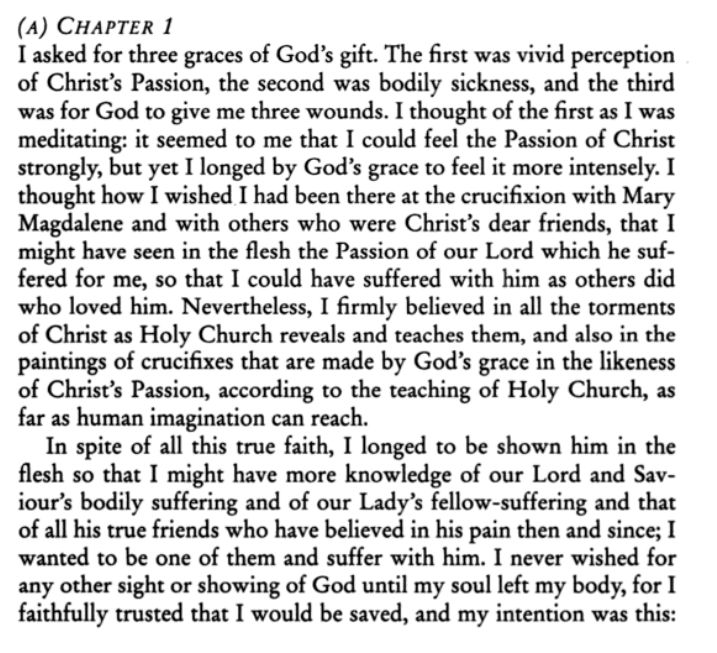The Mystics #1: Julian of Norwich

By Elizabeth Prata
Introduction
Julian of Norwich (1343 – after 1416) Book: The Showings of Divine Love
Catherine of Siena (1347 – 1380). Book: The Dialogue of St. Catherine of Siena
Hildegard of Bingen (1098 – 1179). Book: Scivias
Bridget of Sweden (c. 1303 – 1373) Book: Celestial Revelations

Encylopedia Britannica says of Julian:
“Julian of Norwich, also called Juliana, (born 1342, probably Norwich, Norfolk, Eng.—died after 1416), celebrated mystic whose Revelations of Divine Love (or Showings) is generally considered one of the most remarkable documents of medieval religious experience. She spent the latter part of her life as a recluse at St. Julian’s Church, Norwich.”
Julian was definitely an “Influencer”. How so, you may ask, especially since she lived the greater part of her life as a recluse? She had visions, and she wrote them down. Her book of visions is considered the first book written by a woman in English.

(CC BY-SA 2.)
Julian was a Roman Catholic anchoress, which is a woman who secludes herself from all life secular and religious, and focuses in her solitude on experiencing the presence of God, praying, and studying. Anchorites and anchoresses usually lived in a sealed up cell attached to a church, with only a window to pass through food, or from which she would dispense advice. The other window would face inside to the church. Hermits wandered around and nuns lived with other nuns in a secluded community. All these are considered people living the monastic life, but an anchoress was the most monastic of all, and as a result in the Middle Ages was the most revered.
When she was 30 years old in 1373, Julian thought she was going to die. She was deathly ill, so ill in fact, that the priest came to administer last rites. At this moment while gazing upon the priest’s crucifix and breathing her next-to-last breath, Julian began to see things she claimed Christ “shewed” her. She called these “shewings.” She received 15 visions that evening while on her deathbed, and the 16th one the next morning. Healed now, she arose, became an anchoress, and wrote them down. She spent the rest of her life building a theology from these ‘shewings.’

Julian’s explanation of her wanting visions and even of wanting a near fatal illness was that she wanted to feel closer to God. She wanted to feel his sufferings.
Julian lived 40 more years. She later more fully described her vision of seeing Christ when she was on her deathbed. His crown of thorns was streaming blood, and His blood each drop as “big as herring’s scales”. This is suspicious because the glorified Jesus now operates as priest in heaven, his hand and side wound still visible (as he showed Thomas) but He is no longer on the cross and is no longer bleeding. He had said, “It is finished”. Catholics though, put Jesus back on the cross. They tie the crucifix symbol on Paul’s statement in the verse from 1 Corinthians 2:2, “For I decided to know nothing among you except Jesus Christ and Him crucified.”
As we read in Aleteia, an an online Catholic news and information website which is Pope approved:
“Paul preaches Christ crucified because an empty cross has no power. The cross that bears the beaten, battered, and bloodied body of Jesus Christ, however, that cross is the “power of God”. So, we “keep Jesus on the cross” because we too preach Christ crucified.”
Julian said the Christ figure that appeared to her gave her a small nut into her hand and He said that ‘it is all that is made’. She said Christ is a mother figure, the divine feminine. She says that God is IN everything. (Panentheism). She believed the human’s true self is sinless (Pelagianism) and contains “a spark of the divine”.
“Our Savior is our true Mother in whom we are endlessly born and out of whom we shall never come.”
Julian of Norwich
The Black Plague hit during Julian’s lifetime (1342-1416). It is the most fatal pandemic recorded in human history. The first wave hit in 1347-1353 and killed 75–200 million people. I can understand the attraction both from Julian and from the public that respected her, of hyper-focusing on God’s love during this tumultuous and scary time.
If you are familiar with this saying, it’s from Julian:
“All shall be well. All shall be well. All manner of thing shall be well.”
This includes those suffering in hell. Julian claims the statement encompasses God’s finalizing things in the end that will make the statement true by addressing hell and punishment of souls, but God doesn’t share with Julian exactly how all will be well with those souls in the end.
Julian’s theology has mixed in some great and true sayings, but mixed in also were heretical things, such as the notion that sin doesn’t really exist and therefore man is not totally depraved. Julian struggled with the idea of sin and its logical consequence, hell. She was hyper-focused on God’s love, so the idea that He is angry with sinners and would punish them for all eternity was confusing to her. However, she stayed on just this side of heresy according to the (false) Roman Catholic church, and was never brought to trial (as Margery Kempe was).
The Bible does not call us to any sort of monastic life. Anchoresses would be considered dead to the world, so much so that a mass for the dead was held for them when they entered their cell to cement that fact. Yet the Bible calls for us to be IN the world. (Philippians 2:15, Mark 16:15). Secluding one’s self from all life whether in a cloistered community as nuns and monks were, or a lone person in a cell as anchorites were, in order to contemplate Christ, is the opposite of what we are called to do. We are to be a light to the lost, we are to gather with the saints, and we are to employ our spiritual gifts for the edification of the brethren. Pietistic asceticism is wrong. It’s just self-righteous legalism and not biblical.
It is sad that people, especially ecclesiastical authorities, would assign credibility to the visions of a woman who was so ill she was moments from death. They did in Julian’s day and they do today. You would think that Julian’s errors or even the fact of her visons no matter how likeable the content, would be a clue that all was not right with her. But no. In Catholicism (a false religion) Julian has a feast day. Anglicans and Lutherans commemorate Julian of Norwich. The Order of Julian of Norwich is a contemplative monastic order of the Episcopal Church. Julian and other mystics are highly regarded today by many. Feminists cling to her and Charismatics look to her.
Tomorrow we will look at another famous mystic, Catherine of Siena.




